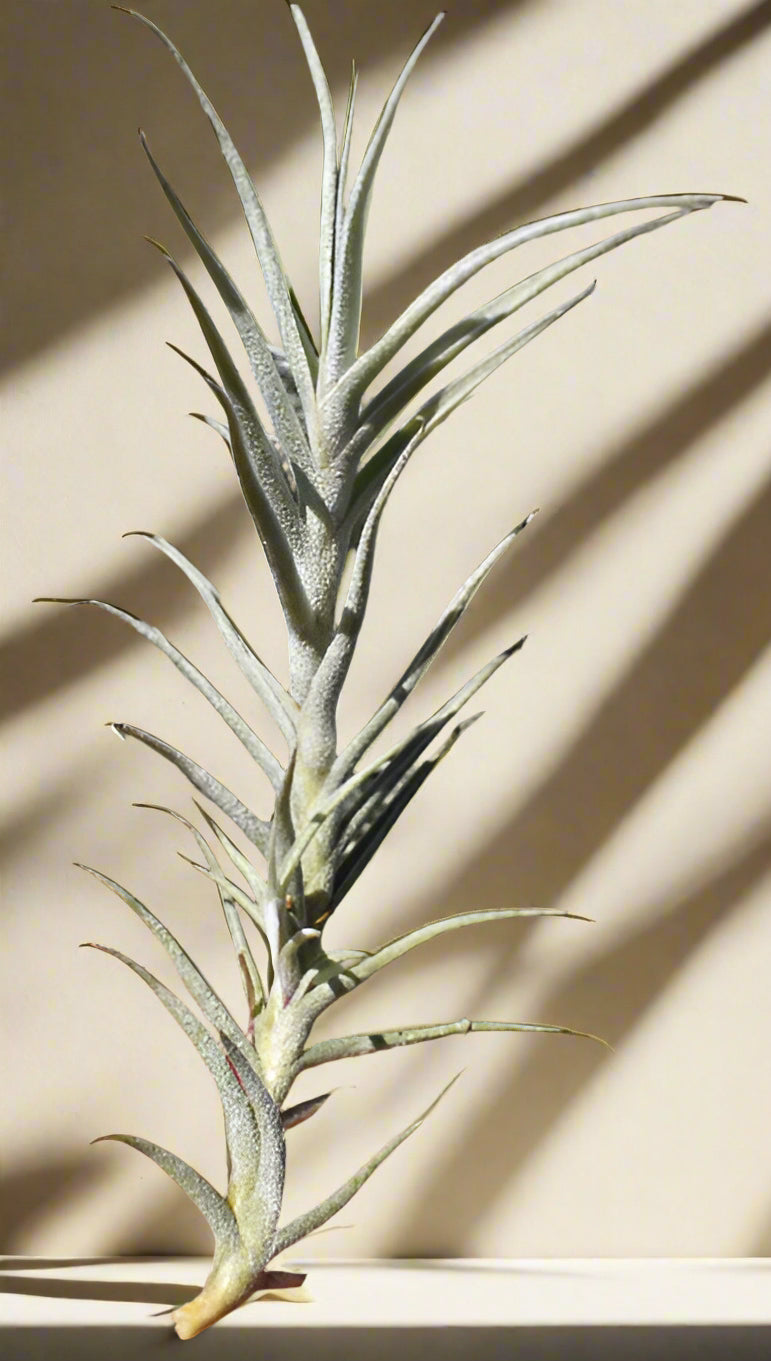Tillandsia Paleacea Large Form Air Plant
- Regular price
-
$6.00 - Regular price
-
- Sale price
-
$6.00
Tillandsia paleacea (Large Form, Small Size 3–4″) is a resilient and charming air plant with soft, silvery leaves covered in fine trichomes, giving it a frosted, air-like appearance. Native to arid and coastal regions, this variety is built for survival—able to absorb moisture from fog and tolerate infrequent watering. Though small now, this large form can grow to nearly double its size over time. When in bloom, it delights with a delicate tri-petal purple flower, about the size of a pea.
Dimensions:
- Height: 3–4 inches (small, young large-form plant)
- Mature Size: Up to 6–8 inches with time
Why You’ll Love It:
- Drought-Tolerant: Perfect for dry environments—thrives with minimal watering.
- Coastal Magic: Can absorb water directly from fog or mist, ideal for low-humidity spaces.
- Tiny But Mighty: Small now, but grows to double in size with care.
- Soft Silvery Texture: Covered in trichomes for a ghostly, ethereal look.
- Charming Blooms: Produces a dainty tri-petal purple flower—small but stunning.
A hardy air plant with coastal roots and quiet beauty, Tillandsia paleacea adds texture, softness, and adaptability to any collection.
Air Plant Care:
- Light: Thrives in bright, indirect sunlight.
- Water: Mist or soak once every 7-10 days.
- Temperature: Grows best between 50-80°F.
- Flowering: Blooms with small, delicate flowers once in its lifecycle.
Perfect Plant For You:
- Easy Care: Requires only occasional misting and indirect sunlight.
- Minimalist Appeal: Perfect for sleek, modern displays or hanging installations.
Couldn't load pickup availability
-
Hurry, only 4 items left in stock!

Air Plant Care FAQs
What is an Air Plant?
An air plant (Tillandsia) is an evergreen, perennial flowering plant from the Bromeliaceae family, native to Central and South America, and even found in parts of the southern USA. True to its name, an air plant doesn’t need soil to grow. It absorbs water and nutrients from the air through its silvery leaves, which are covered in special cells called trichomes.
In addition to their unique feeding method, air plants photosynthesize differently from most plants. They release oxygen at night, making them excellent natural air purifiers.
Light
Air plants thrive in bright, indirect sunlight or under fluorescent lighting in home or office settings. While brief periods of direct sunlight are fine, prolonged exposure to hot sun can dry them out. If your plant is in a spot with direct light, mist it every couple of days to help maintain moisture and keep it hydrated.
Watering
Since air plants don’t require soil, their watering needs are different from traditional houseplants. The two primary methods to water air plants are soaking and misting. Let's break down each technique:
For the Soaking Method, fill a sink or bowl with rainwater, aquarium water, or tap water that has been left out overnight to allow chlorine to dissipate. Submerge the air plants in the water for 30 to 60 minutes. After soaking, remove them and ensure they dry completely. You can either place the plants upside down on a clean cloth or paper towel to drain excess water, or use a small fan on a low setting to help them dry faster.
For the Misting Method, lightly spray your air plants with water, ensuring the leaves are thoroughly covered. Misting is ideal for air plants in drier environments or those displayed in hard-to-reach areas like terrariums or mounted on walls.
It’s important to mist your plants 2-3 times a week, depending on the humidity levels in your space. Always make sure the plants dry completely within a few hours after misting to prevent rot. This method can be a convenient way to keep your air plants hydrated, especially for those that aren't easily removed for soaking.
Temperature & Humidity
Air plants thrive in humid conditions with temperatures between 60°F and 90°F, making typical indoor environments perfect for their growth. To keep these soil-free tropical plants healthy, mist them regularly to maintain adequate humidity levels. Bathrooms with windows, kitchens, and laundry rooms are ideal spaces for growing air plants at home.
General Care & Maintenance
Air Plant Issues & Solutions:
- Rot: Caused by prolonged exposure to water or excess moisture. Let the plant dry out fully before returning it to its container.
- Brown Tips: Result from direct sunlight or insufficient moisture. Reduce light exposure and increase hydration.
- Wilting: Caused by underwatering, improper light, or poor air circulation. Ensure optimal care and environmental conditions.
- Yellowing Leaves: Due to excess sunlight, over-fertilization, or overwatering. Adjust care practices accordingly.
- Brown Spots: Often from sunburn, pests, or over-fertilizing. Make necessary adjustments and trim brown tips safely.
Do They Flower & How to Make Them Bloom
Tillandsia air plants bloom just once in their lifetime, often taking up to 3 years to produce their striking flowers. Depending on the variety, blooms range from soft pinks to vivid reds and purples, adding a vibrant touch to their distinctive look.
To encourage Blooming: provide optimal care with bright, indirect light, regular watering, medium to high humidity, temperatures between 60°F-90°F, and essential nutrients.
What are "Pups?"
After an air plant flowers, it produces offsets called "pups." These baby plants emerge from the base of the parent plant and can be separated once they reach about one-third to half the size of the mother.
While the mother plant eventually dies, its life cycle continues through the propagation of its pups, ensuring new growth
Are they Safe?
Yes, air plants are non-toxic and safe for pets.



